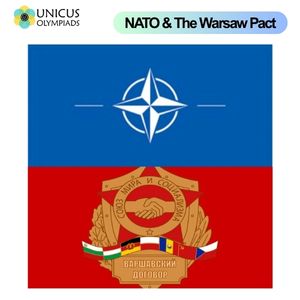

The Cold War, which lasted from the late 1940s to the early 1990s, was defined by political and military tension between the two superpowers of the time: the United States and the Soviet Union. At the heart of this conflict were two major military alliances that shaped global politics: the North Atlantic Treaty Organization (NATO) and the Warsaw Pact. These alliances were formed to solidify the power blocs of the West and the East, respectively, and they played a central role in the dynamics of the Cold War. In this article, we will explore the origins, purposes, and impacts of NATO and the Warsaw Pact, as well as their legacies in the modern world.

The North Atlantic Treaty Organization (NATO) is a military alliance founded in 1949 to provide collective security against the threat posed by the Soviet Union and its allies. NATO's founding members were the United States, Canada, and ten European nations, including the United Kingdom, France, and West Germany. The alliance was based on the North Atlantic Treaty, also known as the Washington Treaty, which established the principles of mutual defense and collective security among its members.
The primary purpose of NATO was to prevent the spread of communism, particularly Soviet influence, in Europe after World War II. The alliance served as a counterbalance to the growing military and ideological power of the Soviet Union and its communist allies in Eastern Europe. NATO's core principle, enshrined in Article 5 of the Washington Treaty, is that an attack on one member state is considered an attack on all members, ensuring mutual defense in the event of an attack on any member.
NATO played a significant role in maintaining peace and stability in Europe during the Cold War by providing a unified military front against Soviet expansion. The alliance helped prevent direct military conflict between the superpowers and acted as a stabilizing force in the post-World War II order. NATO also contributed to the reconstruction of Europe after the war and supported economic recovery through programs like the Marshall Plan.
The Warsaw Pact, officially known as the Treaty of Friendship, Cooperation, and Mutual Assistance, was a military alliance formed in 1955 by the Soviet Union and its Eastern European satellite states in response to NATO. The founding members included the Soviet Union, Poland, East Germany, Czechoslovakia, Hungary, Romania, Bulgaria, and Albania (which later withdrew in 1968). The Warsaw Pact was essentially the Soviet Union's counter to NATO, providing a formal alliance of communist states committed to mutual defense.
The primary aim of the Warsaw Pact was to ensure Soviet control over Eastern Europe and maintain the influence of communist governments in the region. It was also a military counterbalance to NATO's growing power in Western Europe. The Pact allowed the Soviet Union to deploy military forces to its satellite states and maintain political control over the countries in the Eastern Bloc.
The Warsaw Pact was a central component of the Soviet strategy to maintain control over Eastern Europe and deter NATO's influence. While it helped solidify the Soviet Union's sphere of influence, it also led to tensions with the West and internal unrest within the Eastern Bloc. The Pact's existence contributed to the polarization of Europe during the Cold War, with the Iron Curtain dividing the continent into capitalist West and communist East.
The formation of NATO and the Warsaw Pact reflected the ideological, political, and military rivalry between the United States and the Soviet Union during the Cold War. These alliances were emblematic of the division of the world into two opposing camps: the capitalist West, led by the United States and NATO, and the communist East, led by the Soviet Union and the Warsaw Pact. The military buildup and the constant threat of war, particularly the fear of nuclear conflict, defined much of the 20th century.
While NATO and the Warsaw Pact did not directly engage in combat with each other, the rivalry between the two superpowers led to numerous proxy wars and conflicts around the world. The alliances were often at the center of conflicts in regions such as Korea, Vietnam, the Middle East, and Latin America. The goal of both alliances was to spread their respective ideologies—capitalism and democracy in the West, and communism and socialism in the East—through military and diplomatic means.